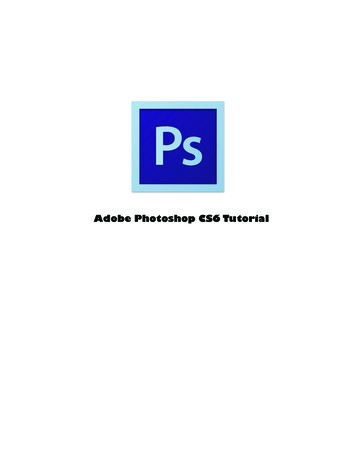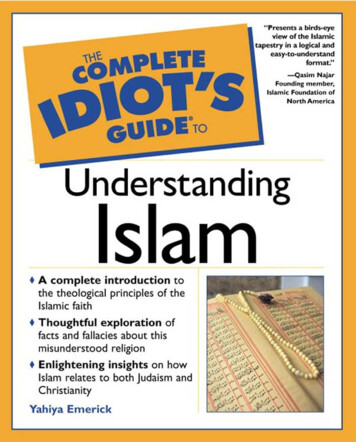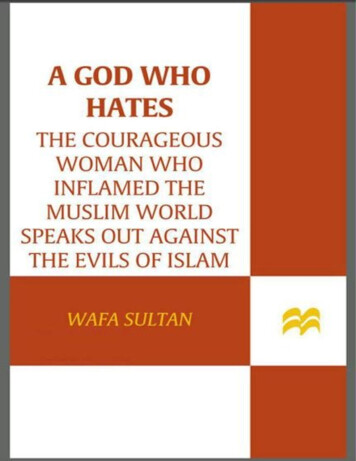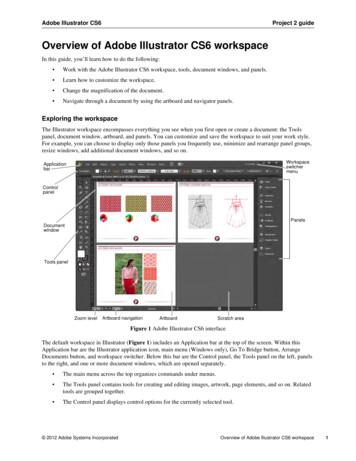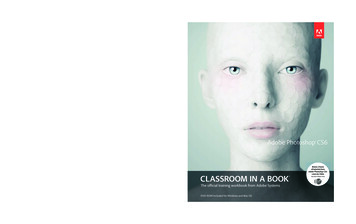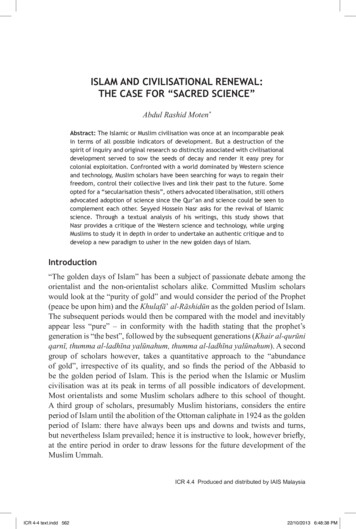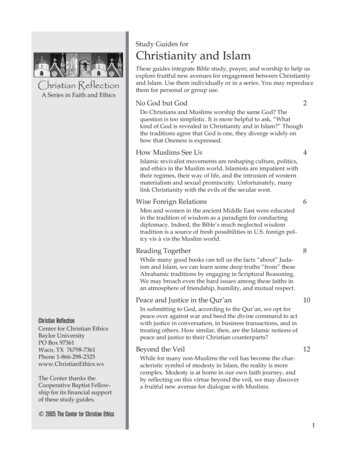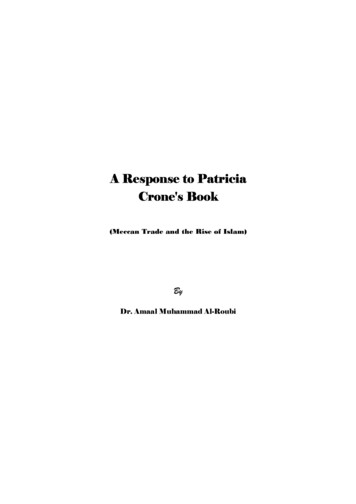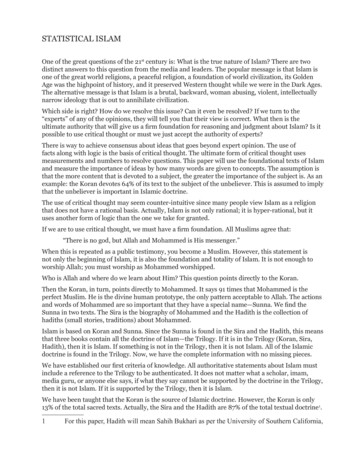
Transcription
STATISTICAL ISLAMOne of the great questions of the 21st century is: What is the true nature of Islam? There are twodistinct answers to this question from the media and leaders. The popular message is that Islam isone of the great world religions, a peaceful religion, a foundation of world civilization, its GoldenAge was the highpoint of history, and it preserved Western thought while we were in the Dark Ages.The alternative message is that Islam is a brutal, backward, woman abusing, violent, intellectuallynarrow ideology that is out to annihilate civilization.Which side is right? How do we resolve this issue? Can it even be resolved? If we turn to the“experts” of any of the opinions, they will tell you that their view is correct. What then is theultimate authority that will give us a firm foundation for reasoning and judgment about Islam? Is itpossible to use critical thought or must we just accept the authority of experts?There is way to achieve consensus about ideas that goes beyond expert opinion. The use offacts along with logic is the basis of critical thought. The ultimate form of critical thought usesmeasurements and numbers to resolve questions. This paper will use the foundational texts of Islamand measure the importance of ideas by how many words are given to concepts. The assumption isthat the more content that is devoted to a subject, the greater the importance of the subject is. As anexample: the Koran devotes 64% of its text to the subject of the unbeliever. This is assumed to implythat the unbeliever is important in Islamic doctrine.The use of critical thought may seem counter-intuitive since many people view Islam as a religionthat does not have a rational basis. Actually, Islam is not only rational; it is hyper-rational, but ituses another form of logic than the one we take for granted.If we are to use critical thought, we must have a firm foundation. All Muslims agree that:“There is no god, but Allah and Mohammed is His messenger.”When this is repeated as a public testimony, you become a Muslim. However, this statement isnot only the beginning of Islam, it is also the foundation and totality of Islam. It is not enough toworship Allah; you must worship as Mohammed worshipped.Who is Allah and where do we learn about Him? This question points directly to the Koran.Then the Koran, in turn, points directly to Mohammed. It says 91 times that Mohammed is theperfect Muslim. He is the divine human prototype, the only pattern acceptable to Allah. The actionsand words of Mohammed are so important that they have a special name—Sunna. We find theSunna in two texts. The Sira is the biography of Mohammed and the Hadith is the collection ofhadiths (small stories, traditions) about Mohammed.Islam is based on Koran and Sunna. Since the Sunna is found in the Sira and the Hadith, this meansthat three books contain all the doctrine of Islam—the Trilogy. If it is in the Trilogy (Koran, Sira,Hadith), then it is Islam. If something is not in the Trilogy, then it is not Islam. All of the Islamicdoctrine is found in the Trilogy. Now, we have the complete information with no missing pieces.We have established our first criteria of knowledge. All authoritative statements about Islam mustinclude a reference to the Trilogy to be authenticated. It does not matter what a scholar, imam,media guru, or anyone else says, if what they say cannot be supported by the doctrine in the Trilogy,then it is not Islam. If it is supported by the Trilogy, then it is Islam.We have been taught that the Koran is the source of Islamic doctrine. However, the Koran is only13% of the total sacred texts. Actually, the Sira and the Hadith are 87% of the total textual doctrine1.1For this paper, Hadith will mean Sahih Bukhari as per the University of Southern California,
Islam is 14% Allah and 86% Mohammed. This is very good news. The Koran is obscure, but anyonecan understand the life and sayings of Mohammed. These statistics point to the easy way to knowIslam—know Mohammed. Anyone, absolutely anyone, can understand Mohammed and hence,Islam.FIGURE 1: THE RELATIVE SIZES OF THE TRILOGY TEXTSHadith60%Koran14%Sira26%The nature of these texts must be made clear. A Muslim believes that the Koran is perfect, complete,universal and eternal. It does not contain the slightest error and it is the exact words of the onlygod of the universe. Mohammed is the perfect example of how to live the sacred life. This idea ofcomplete, final, universal, and perfect textual truth is very hard for non-Muslims to comprehend.Most people read the Koran with the attitude of: “Oh, they don’t really believe this.” When Muslimsread the Koran, their attitude is: “These are the perfect words of Allah.” Muslims call themselvesthe “believers” and by that they mean that they believe the Koran is perfect and Mohammed is theperfect human.ISLAM IS A TEXT-BASED DOCTRINE.Remember, we started with the question: Can we evaluate what the media commentators,politicians, imams and other “experts” say about the true nature of Islam? Yes, we can know thetrue nature of Islam—it is found in the Trilogy. If what the expert has to say can be supported bythe doctrine found in the Trilogy, then it is valid. The Trilogy is the final arbiter of all opinions andstatements about Islam.Critical thought provides a powerful first step. Now, let us measure the doctrine of Islam.THE KORAN OF MOHAMMEDMohammed can be clearly understood, but the Koran must be the most famous book that hasbeen read so little and understood even less. Contrast this with Mohammed’s day. In the Sira (thebiography of Mohammed), we find accounts of illiterate Muslims debating the meaning of theKoran. The Muslims of Mohammed’s day understood the Koran for a simple reason. The Koranof 632 AD (Mohammed’s death) is not the one of today. Every verse had the immediate context ofMohammed’s life. A new verse had the context of what he needed at that time. To all those nearMohammed, each new verse made sense; it had a context and therefore meaning. The voice ofAllah resolved Mohammed’s problems. It is Mohammed’s life that gives the Koran its context andmeaning.The Koran of the bookstore is not the historical Koran of Mohammed, because Uthman, a caliph (supreme ruler) had itarranged starting with the longest chapter and ending at the shortest chapter. After he created the Koran we know today,he burned the originals. The time and story have been annihilated by the rearrangement. From a statistical point of ement/resources/texts/muslim/hadith/bukhari/; Sirawill mean: The Life of Muhammad, by ibn Ishaq, translated A. Guillaume, Oxford University Press,1955; the Koran used will be the Simple Koran, CSPI.
the text was randomized and, hence, very difficult to understand.It is an easy task to reconstruct the Koran of Mohammed’s day, the historical Koran. Take theKoran and rearrange the pages of the chapters in the proper chronological order in a line on a table,since the time order of the chapters is well known. Then take the pages of the Sira (Mohammed’sbiography) and lay them out in a line beneath the Koran. It will be seen that the Sira and theKoran fit together like a key in a lock. The Koran is the warp and the Sira is the woof that forms asingle fabric, the historical Koran. If these two are integrated into one text, the historical Koran isreconstructed.When this reconstruction is done, the Koran becomes the epic story of the rise and triumph of Islamover all of the native Arab culture. The historical Koran is straightforward and not confusing at all.Just as in Mohammed’s day, anyone can understand it.The historical Koran reveals the primary division of the text. The early Koran written in Mecca isvery different from the later Koran written in Medina. The early Koran is more religious and poetic.The later Koran is more historical and political. There is a radical change in its tone, subject andlanguage in the two texts. The difference is even clear to a first-time reader. There is a MeccanKoran and a Medinan Koran. The relative sizes of the two Korans are: Meccan Koran is about 64%of the total Koran; the Medinan Koran is 36% of the total.FIGURE 2: THE DIVISION OF THE KORANMedinan Koran36%Meccan Koran64%THE KAFIRThere is a second division that overwhelms the reader of the historical Koran. A majority of the textconcerns the kafir (unbeliever). It is not about being a Muslim, but about the Kafir. A note: mostKoran translations use the word “unbeliever” instead of Kafir, but Kafir is the actual Arabic word.This term is so important and so unknown that the meaning of Kafir must be defined. The originalmeaning of the word is one who covers or conceals the known truth. A Kafir knows that the Koran istrue, but denies it. The Koran says that the Kafir may be deceived, plotted against, hated, enslaved,mocked, tortured and worse. The word is usually translated as “unbeliever” but this translationis wrong. The word “unbeliever” is logically and emotionally neutral, whereas, Kafir is the mostabusive, prejudiced and hateful word in any language.There are many religious names for Kafirs: polytheists, idolaters, People of the Book (Christians andJews), atheists, agnostics, and pagans. Kafir covers them all, because no matter what the religiousname is, they can all be treated the same. What Mohammed said and did to polytheists can be doneto any other category of Kafir.
Islam devotes a great amount of energy to the Kafir. Not only is the majority (64%) of the Korandevoted to the Kafir, but also nearly all of the Sira (81%) deals with Mohammed’s struggle withthem. The Hadith (Traditions) devotes 32% of the text to Kafirs.FIGURE 3: AMOUNT OF TEXT DEVOTED TO KAFIR68%Meccan Koran57%Medinan Koran64%Total KoranSira81%Hadith37%51%Trilogy Total0%20%40%60%80%POLITICAL ISLAMReligious Islam is defined as doctrine concerned with going to Paradise and avoiding Hell byfollowing the Koran and the Sunna. The part of Islam that deals with the “outsider”, the Kafir, isdefined as political Islam. Since so much of the Trilogy is about the Kafir, the statistical conclusion isthat Islam is primarily a political system, not a religious system.Mohammed’s success depended on politics, not religion. The Sira, Mohammed’s biography, givesa highly detailed accounting of his rise to power. He preached the religion of Islam for 13 years inMecca and garnered 150 followers. He was forced to move to Medina and became a politician andwarrior. During the last 9 years of his life, he was involved in an event of violence every 6 weeks.When he died every Arab was a Muslim. Mohammed succeeded through politics, not religion.An estimate can be made that there were 100,000 Muslims2 when Mohammed died. Using thisinformation allows a graph to be drawn:FIGURE 4: GROWTH OF ISLAMNumber of Muslims100,000150,icslitoPadJihed-MainReligion - MeccaMohammed BeginsPreaching Islam13 Years23 YearsMohammed's DeathThere are two distinct growth processes—religion and politics. Teaching and religion grew at a rate2The History of al-Tabari, volume XI, SUNY, Albany, NY, page 9. Khalid, the sword of Allah, went into battle in 633 AD, with 10,000 Muslim Arab troops at the Battle of Chains. A nation atfull conflict can field an army of about 10% of its population. If 10% is 10,000, then the total population is 100,000.
of about 12 new Muslims per year. Politics and jihad grew at a rate of 10,000 new Muslims per year,an enormous increase. This is a process yield improvement of over 800%. Politics was almost athousand times more effective than religion.If Mohammed had continued with preaching religion we can extrapolate that there would have onlybeen 265 Muslims when he died, instead of the 100,000 that resulted from his politics and jihad.This gives us an estimate of 265 conversions due to religion and 99,7353 conversions to due thepolitical jihad process. We can calculate the relative contributions of religion and politics in growth.Islam’s success was 0.3% religion and 99.7% politics4 at the time of Mohammed’s death, 632 AD.This political importance is reflected in the text of the Sira. There are many more pages devoted to ayear of jihad than there are devoted to preaching Islam. It is instructive to see the amount of the Siratext devoted to these stages of development.FIGURE 5: AMOUNT OF SIRA DEVOTED TO TOPIC22,000Amt. Text per Year25,00020,00015,00010,0005,0004,3000Teaching / ReligionMeccaPolitics / JihadMedinaThe Sira devotes about 5 times as many words to politics than religion on a yearly basis. It givespolitics 5 times the coverage because it is that much more important.Islam’s political nature is also found in the Hadith that devotes 37% of its text to the Kafir.There would be no Islam today, if it were only a religion. Statistics show that Islamic politics is whatbrought Islam success, not religion. To say that Islam is the religion of peace misses the point, sincethe religion is not the core of Islam’s power. It is politics that count, not religion.The statistical conclusion: Islam is primarily a political ideology.ABROGATION AND DUALISMNot only are there two Korans, Meccan and Medinan, that are different in tone and subject matter,but also the Koran has many verses that contradict each other.Koran 2:219 says that Muslims should be tolerant and forgiving to People of the Book.Koran 9:29 says to attack the People of the Book until they pay the jizyah, the dhimmi tax,submit to Sharia law and be humbled.Which verse shows the true nature of Islam?The Koran recognizes its contradictions and even gives a rule to resolve the contradictions. The laterverse abrogates (supercedes) the earlier verse. This does not mean, however, that the earlier verse is34100000 – 265 99,735265/99,735 * 100 0.3%
wrong or in error. This would be impossible since the fundamental hypothesis is that Allah createdthe Koran and, hence, the earlier verse must be true or Allah would be wrong.Abrogation has an impact on the arguments about the true nature of Islam. At endless interfaithdialogs, the early tolerant verse is quoted to show the nature of Islam as being peaceful. When bothverses are quoted and then abrogation is applied, we see that the later verse trumps the earliertolerant one. Jihad abrogates tolerance. In general, the Medinan Koran abrogates the MeccanKoran. In the two verses above, tolerance is abrogated by jihad against the Christians.The earlier verse is true and still used. Abrogation does not negate the early verse. Indeed, theearlier “peaceful” verse that is abrogated is the one most apt to be used in public discourse.This creates a logical problem, since if two things contradict each other, one of them must bewrong. This is a fundamental element of Western unitary logic. In Koranic logic, two statements cancontradict each other and both be true. This is dualistic logic.An alternative explanation is that the early verse is first stage in a process, like a seed, and the laterverse is a second stage, like a plant. There is truth to this, but the process model does not take intoaccount the fact that both truths are available at the same time. To go back to the analogy, you don’thave the seed and the plant at the same time. The verses contradict each other and are both true atthe same time. This is dualistic logic.Another dualistic aspect of Islam is its ethics. One of the chief features of Islam is the doctrine ofthe Kafir. It treats them dreadfully and horribly. No one would ever want to be treated as a Kafir istreated in the Trilogy. This leads us to the Golden Rule. There is no Golden Rule in Islam becauseof the division of humanity into believer and Kafir. The Golden Rule is to treat ALL people as youwould be treated. Since no one wants be treated like a Kafir, and the Kafir is so central to Islamicdoctrine, it shows that Islam has no Golden Rule. Islam has one set of rules for Muslims andanother set of rules for Kafirs. This is dualistic ethics.An example of the dual ethics is the subject of friends. The Koran has 13 verses that say that aMuslim is not to be a friend of Kafirs.JEWSOne of the biggest examples of ethical dualism in Islam is the Jews. The Meccan Koran is filled withstories about Moses, Noah, Adam, and other Jewish figures. The early Koran is very Jewish. Theperception of the Jews completely changes in Medina. Every verse, story, and hadith is negative andanti-Jew. The Trilogy devotes a great deal of material to the Jews.FIGURE 6: JEW HATRED IN THE TRILOGYMeccan Koran1%Medinan Koran17%Sira12%Hadith8.9%Total TrilogyMein Kampf9.3%7%0%10%20%The Trilogy of Medina is even more negative about the Jews than Hitler’s Mein Kampf. What marksthe biggest difference between Mein Kampf and the Trilogy is that Hitler did not write a first sectionin Mein Kampf detailing how much he admired the Jews. There is a contradiction about how the
Koran treats Jews in Mecca and how they are treated in Medina. Due to dualistic reasoning, bothattitudes about the Jews are true, at the same time.THE GOOD IN THE KORANIn the face of these negative statistics, everyone knows of good verses in the Koran. Exactly howmuch material in the Koran is positive for Kafirs? There are 245 verses, 4,018 words, in the Koranthat say something positive about Kafirs. This is about 2.6% of the total Koranic text. However, inevery case, the verse is followed by another verse that contradicts the “good” verses. Also, except for7 verses (58 words), the “good” verse is abrogated later in the same chapter. The other 7 verses arecontradicted in later Suras.The media emphasizes Islam’s positive verses about the People of the Book, the Jews andChristians. Even this turns out to be illusive. Christians and Jews receive the goodness of Islam onlyif they agree that their sacred texts are corrupt, the Koran is true, and that Mohammed is a prophetof the Christian and Jewish religion.In the end there is no unmitigated good for Kafirs in the Koran. What good can be found in the 2.6%of the text is denied later.JIHADJihad must be one of the most famous Islamic concepts. It takes up a large portion of the Trilogy.Material for jihad is 24% of the Medinan Koran and 9% of the total of the entire Koran. Jihad takesup 21% of the Bukhari material and the Sira devotes 67% of its text to jihad.FIGURE 7: AMOUNT OF TRILOGY TEXT DEVOTED TO JIHADHadith21%67%SiraMedinan KoranMeccan Koran24%0%Total Trilogy31%0%20%40%60%80%Statistics gives us a measure of the claim that the real jihad is inner struggle, the so-called “greaterjihad”, whereas the jihad of the sword is the “lesser jihad”. The term “greater jihad” is not found inany of the canonical texts and Reuven Firestone5 claims that it does not exist. However, we do findin the Hadith that some hadiths refer to some religious acts that are equal to jihad of the sword.These quasi-greater jihad hadiths total 2% of the Bukhari hadiths that relate to jihad. Of course,the other 98% of the hadiths devoted to jihad claim that jihad of the sword is the supreme act. Thestatistical answer to the true nature of jihad is that the “greater jihad” of inner struggle is 2% and the“lesser jihad” of the sword is 98%. In other words, jihad is overwhelmingly violent and a little innerstruggle.Statistics also give us a measure of the importance of the jihad of pen and mouth. The Sira devotes23% of its text to war poetry that is propaganda. This poetry, which is not the only example of howMohammed used propaganda for his jihad, furnishes us with an insight into its importance. TheSira devotes roughly a quarter of its jihad text to the jihad of the pen and mouth, and three quarters5Jihad, Reuven Firestone, Oxford University Press, 1952, pg. 139,140. “The source is notgiven and is in fact nowhere to be found.”
of the text to jihad of the sword. The Sira makes no mention of the “greater jihad”, the innerstruggle.WOMENIslam demonstrates duality in its treatment of women. There are separate sets of rules for womenthat come from the Koran and the Sunna.The Islamic Trilogy has a large amount of material that forms the doctrine about women. Each versecan be judged on the position of the female in society. There are a number of verses that praise themother above all men. There are many verses that say that women and men will be judged equallyas to their actions on Judgment Day. In many cases there is no power relationship at all; it is aneutral reference.The process for generating the tables below selects all of the text that contains a reference to thefemale. Then the female data is sorted into four categories: High status, equal status, low status andneutral. Obviously, there are judgments to be made, but in general, if women are selected for specialrules and treatment by men, then those rules make the woman subject to male power.FIGURE 8: WOMEN’S STATUS IN THE KORANHigh status5.3%Equal status23%Low status71%0%20%40%60%80%FIGURE 9: WOMEN’S STATUS IN THE HADITHHigh Status 0.6%Equal Status10%Low Status0%89%20%40%60%80%Notice the broad trend here. In both the Koran and the Hadith the profiles are similar. There is verylittle high status and a small amount of equality. The great majority of the Koran and Hadith textplaces the woman in an inferior or low status to men. This is not unexpected. The Koran and theSunna are the warp and woof, a single fabric, of Islam.THE IMPORTANCE OF NUMBERSWe have always had an interest in numbers as they relate to life. There are two numbers that comeup repeatedly in Islam. The number “1” comes up with the constant proclamation of there is onlyone god. What is noticeable is how often the number “2” arises. There are two Korans, the divisionof humanity into two groups, believer and Kafir, two manifestations of Mohammed, the preacherand the politician. Even the Shahada [the testimony to become a Muslim] is made of two parts, oneis about god and the other is about Mohammed. The ultimate statement is both divine and human,dualism. Islam’s ethics are dualistic and based on the division of humanity into two classes, believerand Kafir. The Koran advances a dualistic logic. Islam uses the practice of political duality to try toattain the goal of spiritual unity.
STATISTICSStatistics give us a very different vision of any text, but in the case of Islamic texts, it is a revelation.Statistics show us an entirely different view of Islam. The statistical vision is holistic and includesthe entire text as a reference. It is a common criticism that any negative comment about Islam istaken out of context. Statistics gives us a complete context.A question was posed at the beginning of this article: How do we decide which is the true view ofIslam? Based upon unitary logic, we expect that one side or the other is true, but in a dualistic truthsystem both sides of the question can be valid. Therefore, the proper answer is that both sides aretrue.In fact, the question is poorly posed. You can never resolve the question by looking for the onetrue answer. It does not exist in a dualistic system. Instead statistics must be used to measure theanswer. We saw, in the case of the lesser jihad/greater jihad that jihad is 2% inner struggle and 98%lethal force. Only statistical answers can be used in a dualistic system. The well-posed question ishow much doctrine is on one side of the question and how much doctrine is on the other side?Statistical models give us a systemic look at Islamic doctrine and show broad trends. The usualverse-quoting method not only ignores Mohammed, but also examines a single point, a verse.Statistics gives us a macro-view, not a micro-view. We can see the entire pattern and can identify thegeneral principles at work.SUMMARYCritical thought brings new insights to the study of Islam. Islam is not a matter of opinion, but hasa solid rational basis in its foundational texts. Simple statistics reveal the systemic nature of Islamicdoctrine.Here are principles that a simple statistical analysis shows:Islamic doctrine is found in the Koran, the Sira and the Hadith—the Trilogy. Any explanationof Islam that does not include the doctrine found in the Trilogy is wrong or incomplete.The Koran is a small part of Islamic doctrine. The Sunna of Mohammed is textually moreimportant than the Koran.The Koran can be understood by reconstructing the Koran of Mohammed, the historicalKoran.The Kafir is the major doctrinal focus of Islam. The Kafir has the lowest status of all animallife. The doctrine of the Kafir is defined as political Islam.Islam’s success was not based on the religion alone, but also on politics and jihad.The Sira devotes most of its attention to jihad and politics, not religion.Islamic doctrine is dualistic in its reasoning and ethics.Jew hatred is an integral part of the Trilogy.There is no unmitigated good in the Koran for Kafirs.Jihad was integral to Islam’s success and forms a large part of the Trilogy.The Islamic doctrine subjugates women.
THE FOUNDATIONALIST SCHOOLIt is clear by now that there is an intellectual underpinning to this paper. All actions and words ofIslam have their foundation in the doctrine of Islam found in the Koran and the Sunna, the Trilogy.This doctrine must be analyzed and understood on a rational basis and on its own merits. Know thefoundational doctrine and apply it to every action by Muslims, but first know the doctrine.If an opinion or comment about Islam does not have a reference, or a possible reference, to thefoundation of the Trilogy, then the opinion has no merit.
Koran fit together like a key in a lock. The Koran is the warp and the Sira is the woof that forms a single fabric, the historical Koran. If these two are integrated into one text, the historical Koran is reconstructed. When this reconstruction is done, the Koran becomes the epic story of the rise and triumph of Islam

